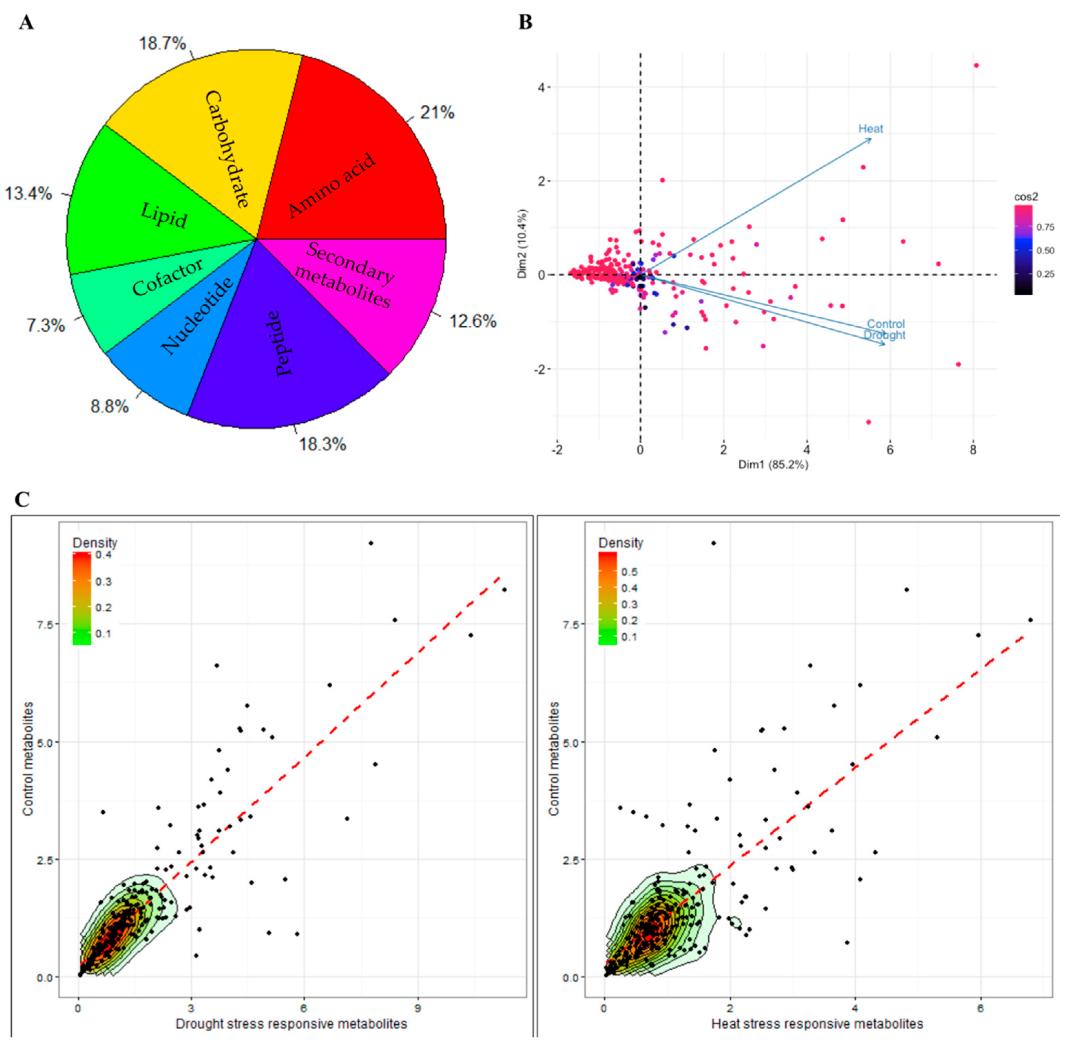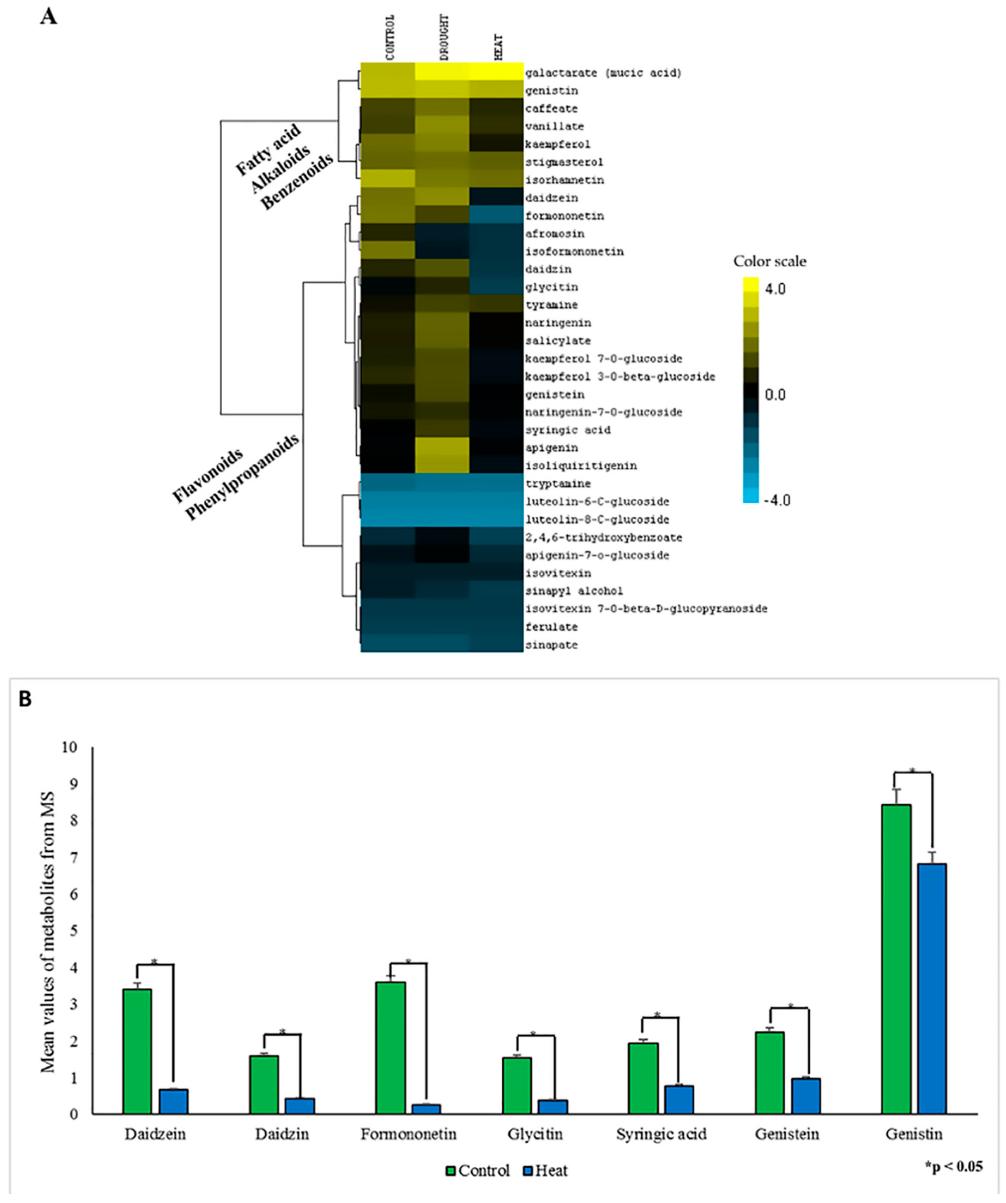Glycine max Metabolomics
Glycine max, commonly known as soybean, is a significant crop with diverse agricultural and economic applications. Metabolomics, a branch of systems biology, involves the comprehensive study of small molecules (metabolites) within a biological system. In the context of Glycine max, metabolomics focuses on analyzing and understanding the composition and changes in metabolites present in soybean plants.
Metabolomics employs advanced analytical techniques such as mass spectrometry (MS) and chromatography. These methods allow researchers to identify and quantify a wide range of metabolites present in soybean plants. These metabolites include primary metabolites like sugars and amino acids, as well as secondary metabolites such as flavonoids and isoflavones. Understanding these metabolites provides insights into various aspects of soybean biology.
Glycine max Metabolomics Analysis Project at Creative Proteomics
Metabolite Profiling: Creative Proteomics may offer comprehensive metabolite profiling services for Glycine max samples. This could involve the use of techniques such as liquid chromatography-mass spectrometry (LC-MS) or gas chromatography-mass spectrometry (GC-MS) to identify and quantify a wide range of metabolites within the plant.
Targeted Metabolomics: They might provide targeted analysis of specific classes of metabolites in Glycine max, such as amino acids, organic acids, sugars, lipids, and secondary metabolites like isoflavones. This can provide a focused understanding of key metabolic pathways.
Untargeted Metabolomics: Creative Proteomics could perform untargeted metabolomics, where a broad range of metabolites in Glycine max samples is profiled without prior bias. This can help identify novel metabolites and unexpected metabolic responses.
Metabolic Pathway Analysis: The company might offer services to reconstruct and analyze metabolic pathways within Glycine max based on the identified metabolites. This can provide insights into the functional relationships between different metabolites and pathways.
Comparative Metabolomics: Creative Proteomics could offer comparative analysis of metabolomes between different Glycine max varieties, developmental stages, or growth conditions to identify differences in metabolic profiles.
Data Analysis and Interpretation: They may provide comprehensive data analysis services, including statistical analysis and visualization of metabolomics data. This can help researchers make sense of complex metabolomics datasets.
Customized Services: Depending on researchers' needs, they might offer tailored services for specific Glycine max metabolomics research goals.
Glycine max Metabolomics Analysis Techniques
Liquid Chromatography-Mass Spectrometry (LC-MS)
Utilizing high-performance instruments such as Agilent 6550 iFunnel Q-TOF LC/MS, we offer comprehensive profiling of Glycine max metabolites. This technique provides a deep understanding of primary and secondary metabolites, aiding in stress response studies, pathway elucidation, and more.
Gas Chromatography-Mass Spectrometry (GC-MS)
Our Thermo Fisher TRACE GC Ultra / ISQ Mass Spectrometer empowers us to analyze volatile and thermally stable metabolites in Glycine max. This method is crucial for investigating essential compounds that contribute to plant development and interactions with the environment.
Tandem Mass Spectrometry (MS/MS)
Through our Thermo Fisher Q Exactive series instruments, we offer tandem mass spectrometry for structural analysis of Glycine max metabolites. This technique uncovers intricate metabolic relationships, shedding light on how various compounds contribute to soybean physiology.
Direct Infusion Mass Spectrometry (DI-MS)
Our Waters Xevo G2-S QTof allows for rapid direct infusion mass spectrometry. This technique is ideal for high-throughput analyses, quickly identifying and quantifying Glycine max metabolites without the need for extensive sample preparation.
Application for Glycine max Metabolomics
Stress Response Analysis: Metabolomics can be used to study how Glycine max responds to abiotic stresses like drought, heat, and salinity, as well as biotic stresses like pathogens and pests. By identifying changes in metabolite levels, researchers can uncover the plant's adaptive strategies and potential markers for stress resistance.
Crop Improvement: Metabolomics can aid in breeding programs aimed at developing Glycine max varieties with enhanced traits such as higher yield, improved nutritional content, and stress tolerance. Metabolite profiling can help identify markers associated with desirable traits.
Nutritional Analysis: Glycine max is a key source of protein and other nutrients in human and animal diets. Metabolomics can provide insights into the composition of essential nutrients, anti-nutritional compounds, and bioactive metabolites that contribute to the plant's nutritional value.
Quality Assessment: Metabolomics can be used to assess the quality and authenticity of Glycine max products, such as food ingredients, supplements, and industrial materials derived from soybeans.
Understanding Secondary Metabolites: Secondary metabolites in Glycine max, such as isoflavones and flavonoids, have various health benefits and industrial applications. Metabolomics helps in understanding the biosynthesis and regulation of these compounds.
Growth and Development Studies: Metabolomics can shed light on the metabolic changes that occur during different developmental stages of Glycine max plants, from germination to flowering and seed formation.
Metabolite-Microbiome Interactions: Metabolomics can reveal the interactions between Glycine max and its associated microbiota, especially in the rhizosphere. This has implications for plant health, nutrient uptake, and soil health.
Pharmacological and Medicinal Uses: Some Glycine max metabolites have potential pharmaceutical applications. Metabolomics can help identify and characterize these metabolites for medicinal purposes.
Functional Genomics: Metabolomics data can complement genomics and transcriptomics studies, providing insights into how gene expression translates into metabolic changes.
Environmental Monitoring: Metabolomics can be used to assess the impact of environmental factors on Glycine max metabolism, contributing to our understanding of plant-environment interactions.
Research on Co-occurring Compounds: Metabolomics can uncover the presence of co-occurring metabolites that might interact with Glycine max metabolites, leading to novel discoveries.
 Workflow for Plant Metabolomics Service
Workflow for Plant Metabolomics Service
Sample Requirements for Glycine max Metabolomics
| Sample Type |
Sample Amount |
Biological Replicates |
| Leaf Tissue |
100 mg |
3 |
| Root Tissue |
150 mg |
3 |
| Seed Extract |
50 mg |
3 |
| Flower Petals |
80 mg |
3 |
Case 1. Metabolic Responses of Soybean Leaves to Heat and Drought Stress
Background:
Plants are constantly exposed to various environmental stresses, such as heat and drought, which can significantly impact their growth and productivity. Understanding how plants adapt to these stressors at the molecular level is essential for developing strategies to enhance their resilience and agricultural productivity. Metabolomics, a comprehensive study of small molecule metabolites, offers insights into the dynamic changes that occur in response to stress and provides a holistic view of cellular responses.
Samples:
In this study, soybean plants (Glycine max L. cultivar: Williams-82) were used as the model organism. Soybeans are important crops with high nutritional value and economic significance, making them an ideal choice for investigating stress responses. The focus was on the leaves of these plants, as leaves play a central role in photosynthesis, energy production, and stress signaling.
Methods:
Metabolomics profiling was conducted using cutting-edge analytical techniques to capture a snapshot of the metabolites present in soybean leaves under different stress conditions.
- Gas Chromatography-Mass Spectrometry (GC-MS): GC-MS is a powerful analytical technique used to identify and quantify volatile and semi-volatile metabolites. In this study, it was employed to analyze metabolites that can be vaporized without decomposition. The technique involves two main steps: gas chromatography separates the metabolites, and mass spectrometry identifies and quantifies them based on their mass-to-charge ratios.
- Liquid Chromatography-Mass Spectrometry (LC-MS): LC-MS is another advanced method that enables the detection and quantification of a wide range of metabolites, including polar and non-polar compounds. It involves liquid chromatography to separate metabolites followed by mass spectrometry for identification and quantification based on mass and charge properties.
Results
The metabolomics analysis revealed significant insights into how soybean plants responded to heat and drought stresses at the metabolic level. Under heat stress, the overall number of metabolites decreased, indicating a disruption in various metabolic pathways. Carbohydrate metabolism was adversely affected, with key metabolites involved in glycolysis and the pentose phosphate pathway showing reduced abundance. Amino acid metabolism, including essential amino acids such as lysine and isoleucine, was also negatively impacted.
Interestingly, nitrogen metabolism, peptide metabolism, nucleotide metabolism, and secondary metabolite pathways were also altered in response to stress. Secondary metabolites like isoflavones, known for their antioxidant properties, decreased under heat stress, potentially impacting the plant's ability to counteract oxidative damage.
Through the integration of computational tools like MapMan and Metscape, the study gained deeper insights into the intricate interactions between metabolites and their involvement in various metabolic pathways.
In conclusion, the combination of advanced metabolomics techniques provided a comprehensive understanding of how soybean plants adjust their metabolite profiles in response to heat and drought stresses. This knowledge has implications for developing stress-tolerant crop varieties and improving agricultural productivity in the face of changing environmental conditions.
 Metabolomics data of soybean leaves under drought and heat stress
Metabolomics data of soybean leaves under drought and heat stress
 Effect of drought and heat stress on secondary metabolites.
Effect of drought and heat stress on secondary metabolites.
Reference
- Das, Aayudh, Paul J. Rushton, and Jai S. Rohila. "Metabolomic profiling of soybeans (Glycine max L.) reveals the importance of sugar and nitrogen metabolism under drought and heat stress." Plants 6.2 (2017): 21.


 Workflow for Plant Metabolomics Service
Workflow for Plant Metabolomics Service Metabolomics data of soybean leaves under drought and heat stress
Metabolomics data of soybean leaves under drought and heat stress Effect of drought and heat stress on secondary metabolites.
Effect of drought and heat stress on secondary metabolites.

